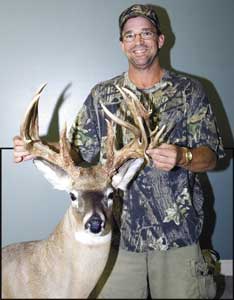
The annual breeding dance is beginning at Tensas River National Wildlife Refuge. Will you be there for the party?
The deer wasn’t supposed to be there. Robert Chenier was sitting a couple hundred yards from where the buck was expected to be, not because he didn’t want to kill a big deer. No, it was because one of his buddies had claimed the prime spot.
The place to kill a big buck was obvious.
“This deer had ground scrapes I guarantee were 5 feet around,” the Chenier said. “He also had hit a lot of trees, big trees.”
The morning the scrape line was found, there was fresh urine in one of the large pawings.
“The buck or a doe must have come through there that morning,” the Vacherie hunter said.
The sign was found in an area Chenier and four of his buddies had hunted for several years, so there already was a bit of a predetermined pecking order. That meant Gasper Brazon could claim the privilege of hunting the scrapes without question.
“He always hunts that area, so he was sitting over the scrapes,” Chenier said.
That morning, there were fresh droppings in the scrape nearest to Brazon’s stand site. It seemed deer were working the line hard, and it was just a matter of being on stand when the buck made a pass along the scrapes.
But the plan didn’t really matter much the morning of Nov. 25, 2005: Chenier had heard something moving through the tall, thick palmettos about 7:45 a.m., and he was peering for a glimpse of the animal moving about on the forest floor.
Movement finally caught his eyes, and soon thereafter a deer materialized out of the thick palmettos.
“I saw the horns shining, but that was about it,” he said. “I put the scope on him, and it blew my mind.”
The deer was no ordinary Tensas River National Wildlife Refuge buck — tines resting on stout beams seemed to sprout all over its head.
Chenier quickly readied for a shot, waiting anxiously for the deer to move into a more-open area in the thick cover.
“When I shot him, he was less than 30 yards from me,” Chenier said.
The deer bolted, and then did something that still puzzles the hunter.
“He stopped,” Chenier said. “He just stood there.”
It was unbelievable. The frantic hunter thought he must have missed the shot, but the deer was in an area where he couldn’t get a clear follow-up shot without some contortion.
“I had to sit on the bottom of my stand to get a clear shot,” Chenier said. “He stood there maybe five minutes until I got another shot on him, until I figured out how to get another shot.”
The buck ran again, and Chenier heard him crash to the ground. But soon, he heard something that worried him once again.
“I heard him get up and walk away,” he said. “I said, ‘Lord, I missed that deer.’”
He waited a few minutes before clambering down the tree and fetching Brazon to help him look for the deer.
“I wanted to get back in the tree and tell him where I saw him last,” Chenier said.
Brazon was soon standing where the buck was when the second shot rang out, and he found plenty of blood.
“I got down and went to find the deer with him,” Chenier said. “He hadn’t gone far.”
Amazingly, both shots had connected with the deer.
“The first shot hit him in front of the shoulder,” he said. “The second was right where it should have been — behind the shoulder.”
That wasn’t determined for a few minutes, however. It was the rack that held the two hunters’ attention.
There were 19 points arrayed around the thick frame, and the bases were massive. The deer later scored out at 178 1/8 Boone & Crockett.
“It’s a non-typical,” Chenier said. “It has 13 points on the right side, and 6 points on the left side.”
He couldn’t believe his luck.
“The deer must have passed through (the scrape line) that morning and was working its way back,” he said. “I was just in the right place. Gasper was actually happy I had killed it.”
But his buck was only the largest of the deer killed in 2006 by the Vacherie crew and five other buddies from Chackbay.
“We killed eight bucks last year,” Chenier said. “Five of them were mountable.”
That rate of success wasn’t just happenstance: It was made possible because the hunters have come to understand how to hunt Tensas’ bottomland hardwoods.
The first key is scouting.
Chenier and Chackbay friend Marcus Trosclair Jr., who has hunted the refuge for about 12 years, said they both make concerted efforts to learn the lay of the land before they ever sit a stand.
“We get there two days early to scout,” Chenier said. “We spend a lot of time looking around before we hunt.”
Trosclair said the group from Chackbay also schedules in a couple of extra days to learn how deer patterns have changed from the prior year.
But the approaches of the two groups are completely different.
Click here to read the rest of this story, which first appeared in the December 2006 issue of Louisiana Sportsman.
